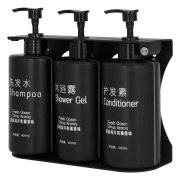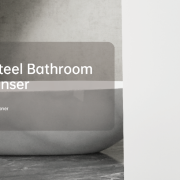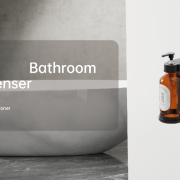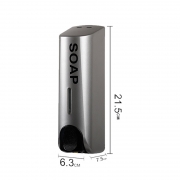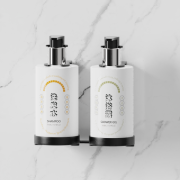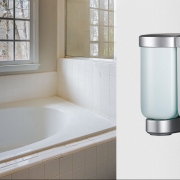That humble vessel by your sink – the soap dispenser – holds more power than you might think. Beyond just delivering suds, it represents a daily choice with significant environmental and economic consequences: disposable, single-use dispensers versus their refillable, reusable counterparts. It’s a battle between ultimate convenience and long-term sustainability. Which one truly cleans up its act? Let’s lather up the facts and dive deep into the pros and cons of each contender.
The Contender: The Disposable (Single-Use) Soap Dispenser
- The Premise:Buy it pre-filled, use it until empty, toss the entire unit (bottle, pump, and all), replace. Rinse and repeat.
- The Allure (Advantages):
- Ultimate Convenience:This is the undisputed king of ease. No messy refills, no hunting for compatible soap. Just grab a new one off the shelf, pop off the cap (or sometimes just twist the pump to activate), and you’re ready to wash. Perfect for short-term rentals, infrequently used guest bathrooms, or situations demanding absolute minimal effort.
- Perceived Hygiene:The “brand new, sealed unit” factor offers a strong psychological sense of cleanliness and germ avoidance. For high-risk environments like hospitals or food prep areas (though often regulated differently), this feels
- Initial Lower Cost (Sometimes):The upfront price for a single disposable unit is often very low, sometimes even appearing cheaper than buying a refillable dispenser plus soap initially.
- Guaranteed Compatibility:The soap is perfectly matched to the pump mechanism, eliminating clogs or poor performance due to soap viscosity issues. What you buy is what you get.
- Design Variety:Manufacturers constantly roll out new designs, colors, and fragrances. Want seasonal scents or trendy aesthetics? Disposables offer frequent novelty.
- The Downside (Disadvantages):
- Environmental Impact – The Elephant in the Room: This is the major, glaring flaw. Disposable dispensers are a plastic waste disaster. Every single empty unit ends up in landfill (or worse, litter), contributing massively to plastic pollution. Even if recycled (which requires separating components – often not done), the sheer volume is unsustainable. Think about the pump mechanism, the spring, the bottle – all trashed after a single use.
- Long-Term Cost: While cheap upfront, constantly buying entirely new dispensers is significantly more expensive over time compared to buying large refill bags or bottles of soap. You’re paying for plastic packaging repeatedly.
- Resource Intensity: Manufacturing each new dispenser (plastic molding, metal spring, assembly, packaging, transportation) consumes far more raw materials and energy than simply producing a refill pouch.
- Limited Soap Choice: You’re locked into the specific soap formulation and scent that came with the dispenser. Want to switch to an organic, hypoallergenic, or different scent? You need a whole new dispenser.
- Potential for Waste: If the pump fails prematurely or the soap isn’t fully depleted when you feel the need to replace it (perhaps for hygiene perception), usable soap and functional plastic are wasted.
The Challenger: The Refillable Soap Dispenser
- The Premise: Invest in one durable dispenser. Keep it functioning for years by adding soap from pouches or bulk bottles when it runs low. The dispenser itself is designed for longevity.
- The Strengths (Advantages):
- Significant Environmental Win: This is the core benefit. Refillables drastically reduce plastic waste. You discard only the thin plastic refill pouch (which uses much less plastic than a rigid bottle and pump) or, even better, refill from large bulk containers. Over years, the savings in landfill contribution are immense.
- Cost-Effectiveness: While the initial dispenser purchase might be higher, the long-term savings are substantial. Buying soap in bulk refill pouches or large bottles is significantly cheaper per ounce than constantly buying new disposable units. You pay for soap, not redundant plastic packaging.
- Durability & Quality: Refillable dispensers are generally built better. They often feature higher-quality pumps (metal springs, ceramic pistons), sturdier bottles (glass, thick plastic, stainless steel), and more robust mechanisms designed for repeated use. They feel less flimsy.
- Freedom of Choice: Unleash your inner soap connoisseur! Easily switch between different soap types (hand, dish, antibacterial, moisturizing), brands, scents, or formulations (organic, hypoallergenic, unscented) without changing your dispenser. Buy large economical refills of your favorite brand.
- Aesthetic Flexibility & Personalization: Refillables come in a vast array of durable, attractive materials and styles (glass, ceramic, bamboo, sleek metal) that can complement your home decor long-term. They offer a more permanent, personalized look.
- Reduced Resource Consumption: Manufacturing one durable dispenser used for years consumes far fewer resources overall than producing dozens of disposable ones.
- The Challenges (Disadvantages):
- Refilling “Hassle”: This is the main perceived drawback. Refilling requires an extra step – opening the dispenser, pouring or squeezing in new soap (sometimes messily), and closing it up. It’s less instantaneous than grabbing a new disposable.
- Cleaning Needs: To prevent soap scum buildup, bacterial growth (especially around the pump mechanism), or residue mixing between refills, periodic cleaning is necessary. This adds another maintenance task.
- Initial Investment: A well-made, attractive refillable dispenser costs more upfront than a single disposable one.
- Potential for Clogs/Leaks: Using very thick or incompatible soaps, or failing to clean the pump occasionally, can lead to clogging or leaking, especially with cheaper refillable models. Requires a bit more user attention.
- Refill Compatibility: While generally flexible, some pump mechanisms might struggle with extremely viscous soaps. You need to ensure your chosen soap works well with your dispenser’s pump.
The Verdict: Towards a More Sustainable Suds Future
The evidence overwhelmingly favors refillable soap dispensers for the vast majority of home and regular business uses. While disposables offer undeniable, albeit fleeting, convenience and a strong perception of hygiene, their environmental cost is simply too high to justify as a default choice in our plastic-choked world. The constant generation of complex plastic waste is unsustainable.
Refillables represent a smarter, more responsible approach:
- Planet-Friendly: Drastically reduce plastic waste and resource consumption. One durable dispenser replaces dozens, if not hundreds, of disposable units over its lifetime.
- Wallet-Friendly: Save significant money over the long haul. The initial investment is quickly recouped through the drastically lower cost per wash of bulk soap refills. You stop paying for redundant packaging and mechanisms.
- Quality & Choice: Offer better durability, aesthetics (materials like glass, stainless steel, ceramic elevate any space), and freedom in soap selection. Enjoy higher-performing pumps and the ability to experiment with different formulations.
Addressing the Concerns: The “hassle” of refilling is minimal – it takes mere seconds and quickly becomes routine. Cleaning is simple (a warm water rinse and occasional vinegar soak for the pump mechanism) and is actually crucial for maintaining hygiene in any dispenser type over extended periods. The initial cost is a one-time investment in quality that pays dividends.
When Disposables Might Make Sense (The Exceptions):
- Truly Temporary Situations: Short-term vacation rentals, weekend cabins, construction sites, or disaster relief scenarios where setting up and retrieving a permanent fixture isn’t practical.
- Specific High-Sterility Protocols: Certain controlled environments like isolation rooms in hospitals or specialized labs might mandate sealed, single-use units under strict protocols (though often, professionally managed bulk-fill systems with sterile bags are preferred).
- User Compliance Challenges: In some uncontrolled public restroom settings where vandalism is a concern or ensuring proper refilling/cleaning procedures by staff or the public is impossible (though large, wall-mounted bulk-fill systems are increasingly the better solution here too).
Making the Switch Smoothly & Effectively:
- Invest Wisely: Choose a refillable dispenser made of durable, easy-to-clean materials (glass, stainless steel, high-quality BPA-free plastic) with a reliable, well-reviewed pump mechanism. Look for wide-neck openings for easier filling.
- Find Your Optimal Refill: Look for soap sold in large, flexible pouches designed for refilling or concentrate that you dilute. Many eco-conscious brands now offer specific “eco-refill” options. Buying in gallon-sized containers maximizes savings and minimizes packaging per ounce.
- Embrace Bulk Buying: For home use, purchasing soap in the largest economical size (gallons, multi-packs of refill pouches) significantly reduces cost per use and overall packaging waste.
- Establish a Cleaning Routine: Incorporate cleaning the dispenser into your regular bathroom or kitchen deep clean. Every few refills (or monthly), disassemble the pump if possible, rinse all parts thoroughly with warm water, and soak in a vinegar solution to dissolve soap scum and mineral deposits. Rinse well before reassembling. Wipe down the exterior regularly.
- Match Soap to Pump: If using very thick lotion soaps or castile soap, ensure your dispenser’s pump is rated for higher viscosity to prevent clogs. Most standard pumps handle regular liquid hand or dish soap perfectly.
Conclusion: A Choice Beyond Convenience
The seemingly simple choice between a disposable and refillable soap dispenser is a microcosm of our modern consumption habits. It pits the seductive ease of the throwaway culture against the mindful responsibility of reuse. While disposable dispensers offer an undeniable, frictionless experience, their true cost – measured in mountains of plastic waste, squandered resources, and higher long-term expenditure – is one our planet and wallets can ill afford.
Refillable soap dispensers, requiring just a minimal increment of effort (seconds for refilling, minutes for occasional cleaning), deliver profound benefits: a dramatic reduction in plastic pollution, substantial financial savings over time, superior durability and aesthetic appeal, and the liberating freedom to choose any soap you desire.
Choosing refillable is more than just a practical decision; it’s a small, tangible step towards a more sustainable future. It fosters a conscious relationship with everyday objects and disrupts the cycle of constant consumption. By embracing the refill, we actively participate in reducing waste and conserving resources.
So, next time your soap runs low, consider making the switch. Invest in a dispenser built to last, enjoy the variety and savings of bulk soap, and take pride in that small act of environmental stewardship. It’s time to move beyond the disposable model, one simple, satisfying refill at a time. Your hands, your budget, and the Earth will feel the positive difference.


